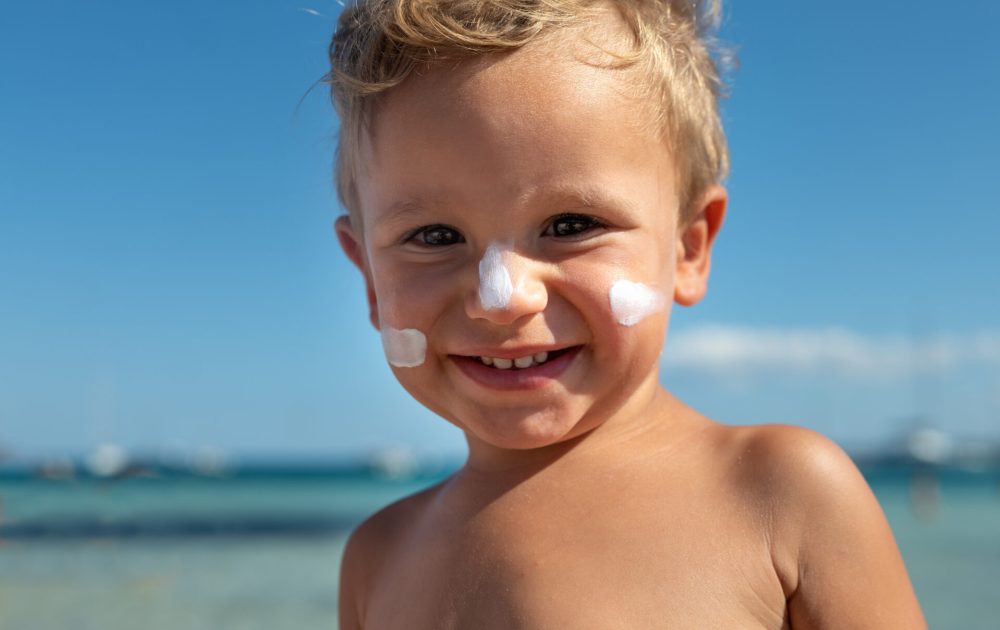Our test tells you which everyday chemicals you've recently come into contact with, and easy steps you can follow to reduce your exposure to them.
Sunscreen - mineral or chemical?

Staying safe in the sun is fundamental to our health with dermatologist recommending their use on a daily basis, and especially during the summer months when the sun’s rays are at their strongest. But as you reach for the sunscreen, you may wish to consider what ingredients are being used. There are two main types of sunscreens to choose from, mineral and chemical based.
Mineral based sunscreens
These are often referred to as sunblocks because they create a barrier against the sun, preventing UV rays from penetrating the skin, reflecting it instead. They work immediately after application to reduce the effects of sun exposure on skin because they are not absorbed by skin. For anyone with skin sensitivity, mineral based sunscreens might be more suitable, but always check with a dermatologist first.
Zinc oxide is the most commonly used ingredient in mineral based sunscreen. It is a white, powdery mineral that can help block harmful UV rays from the skin and prevent sunburn. Zinc oxide is sometimes used in conjunction with titanium dioxide, but zinc oxide is thought to give better sun protection. Some products combine both ingredients, so check the label to be sure.
When used as a sunscreen mineral sunblocks can leave a white, chalky layer on the skin, although added colorants can lessen this effect. When this is no longer visible, it’s time to reapply the sunscreen, usually every two hours. It’s important to use the correct amount of mineral sunscreens to provide a good level of UV protection – use around two teaspoons for your face, neck, and arms, and up to two tablespoons for your whole body, depending on your size.
Chemical based sunscreen
Sunscreens with chemical ingredients work differently to mineral based sunscreens. A key difference between mineral and chemical sunscreens is that chemical formulations are absorbed into the skin, whereas mineral sunscreens sit on the surface of the skin. Chemical ingredients are selected for their ability to absorb the sun’s rays and break them down, which reduces the sun’s harmful effects. This absorption is considered a potential health risk by some scientists.
Oxybenzone (OBZ)
This is one of the most common ingredients used in chemical sunscreens. Oxybenzone is used for its ability to absorb and convert UV rays including UVB and UVA. Oxybenzone is another name for Benzophenone-3, or BP-3, which has been found in the urine of nearly all people tested in an American study. Studies show that up to 3% of oxybenzone can be absorbed through the skin at the permitted concentration of 6%.
BP-3 has been linked with increased breast cancer, lower birth weights, and lower male fertility rates. The European Scientific Committee on Consumer Safety (SCCS) in 2021 concluded that – “The use of BP-3 as a UV-filter up to a maximum concentration of 6% in sunscreen products, either in the form of body cream, sunscreen propellant spray or pump spray, is not safe for the consumer.”
Oxybenzone has also been found to cause bleaching of coral reefs and other environmental impacts such as marine and plant life.
For a full list of other commonly used chemical ingredients in sunscreens visit the Environmental Working Group website. Many of these chemical substances used in chemical sunscreens are thought to have endocrine disrupting properties.
Sunshine and Vitamin D
Our skin needs regular exposure to the sun to help our body to make vitamin D. Skin has receptor cells that use UVB rays to convert cholesterol in our skin to vitamin D. Our body needs vitamin D to absorb calcium from the intestine, which in turn supports good bone health.
The amount of sun exposure time needed to make adequate levels of vitamin D from varies between winter and summer, when rays are more intense and we tend to have more of our skin exposed. UCLA recommend 8-10 minutes of sun exposure on the skin during summer and up to 2 hours in winter. Vitamin D is stored in fat cells until we need it, so regular exposure to sunshine during the summer months can boost our stored levels for the winter months. If you take vitamin D supplement seek medical guidance on dosage because it is possible to take too much.
Staying safe in the sun
The easiest way to protect your skin from UV rays is to avoid being outside between 11am and 3pm when UV rays are at their strongest. If this isn’t possible, seek shaded areas, cover up, and wear natural sun cream. The Skin Cancer Foundation offer useful guidance about clothing to protect the skin from sun exposure.
Choose a mineral based sunscreen
If you’re concerned about any of the chemicals used in some sunscreens, or would just like a more “natural” product, then consider choosing a mineral based sunscreen. Most use zinc oxide as the protection against UV rays. Brands including Badger, Odylique, and Green People offer sun creams using zinc oxide. Shade company also do a completely natural organic zinc oxide sun cream with just 4 ingredients. Where possible, choose organic and fragrance-free options to avoid chemicals used to add fragrance, because that familiar sunscreen scent is usually made from chemicals that may have endocrine disrupting properties.
More reading
Boots offer helpful guides to sun protection and recommendations for mineral and chemical sun protection products.
Good Housekeeping product testing of mineral sunscreens.